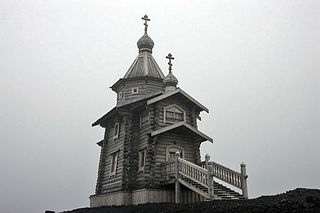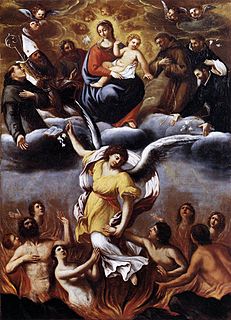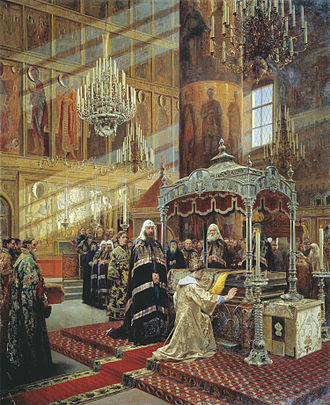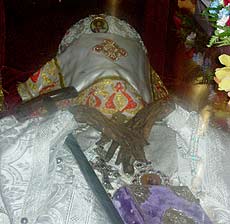
Canonization is the declaration of a deceased person as an officially recognized saint, specifically, the official act of a Christian communion declaring a person worthy of public veneration and entering their name in the canon catalogue of saints, or authorized list, of that communion's recognized saints.

In religious belief, a saint is a person who is recognized as having an exceptional degree of holiness, likeness, or closeness to God. However, the use of the term saint depends on the context and denomination. In Catholic, Eastern Orthodox, Anglican, Oriental Orthodox, and Lutheran doctrine, all of their faithful deceased in Heaven are considered to be saints, but some are considered worthy of greater honor or emulation. Official ecclesiastical recognition, and consequently a public cult of veneration, is conferred on some saints through the process of canonization in the Catholic Church or glorification in the Eastern Orthodox Church.

Veneration, or veneration of saints, is the act of honoring a saint, a person who has been identified as having a high degree of sanctity or holiness. Angels are shown similar veneration in many religions. Etymologically, "to venerate" derives from the Latin verb, venerare, meaning 'to regard with reverence and respect'. Veneration of saints is practiced, formally or informally, by adherents of some branches of all major religions, including Christianity, Judaism, Hinduism, Islam, and Buddhism.

Divine Liturgy or Holy Liturgy is the Eucharistic service of the Byzantine Rite, developed from the Antiochene Rite of Christian liturgy which is that of the Ecumenical Patriarchate of Constantinople. As such, it is used in the Eastern Orthodox, the Byzantine Catholic Churches, and the Ukrainian Lutheran Church. Although the same term is sometimes applied in English to the Eucharistic service of Armenian Christians, both of the Armenian Apostolic Church and of the Armenian Catholic Church, they use in their own language a term meaning "holy offering" or "holy sacrifice". Other churches also treat "Divine Liturgy" simply as one of many names that can be used, but it is not their normal term.

In religion, a relic is an object or article of religious significance from the past, it usually consists of the physical remains of a saint or the personal effects of the saint or venerated person preserved for purposes of veneration as a tangible memorial. Relics are an important aspect of some forms of Buddhism, Christianity, Islam, shamanism, and many other religions. Relic derives from the Latin reliquiae, meaning "remains", and a form of the Latin verb relinquere, to "leave behind, or abandon". A reliquary is a shrine that houses one or more religious relics.

Beatification is a recognition accorded by the Catholic Church of a deceased person's entrance into Heaven and capacity to intercede on behalf of individuals who pray in their name. Beati is the plural form, referring to those who have undergone the process of beatification; they possess the title of "Blessed" before their names and are often referred to in English as "a Blessed" or, plurally, "Blesseds".
The Venerable is a style, title, or epithet which is used in some Christian churches and in Buddhism.
Religions with the belief in a future judgment or a resurrection of the dead or of purgatory often offer prayers on behalf of the dead to God.
Glory is used to describe the manifestation of God's presence as perceived by humans according to the Abrahamic religions.

The communion of saints, when referred to persons, is the spiritual union of the members of the Christian Church, living and the dead, but excluding the damned. They are all part of a single "mystical body", with Christ as the head, in which each member contributes to the good of all and shares in the welfare of all.

Intercession of the Saints is a Christian doctrine held by the Eastern Orthodox, Oriental Orthodox, and Catholic churches. The practice of praying through saints can be found in Christian writings from the 3rd century onward. The 4th-century Apostles' Creed states belief in the communion of Saints, which certain Christian churches interpret as supporting the intercession of saints. However, this practice is controversial in Judaism and Islam.
The process of beatification and canonization has undergone various reforms in the history of the Roman Catholic Church. For current practice, as well as a discussion of similar processes in other churches, see the article on canonization. This article describes the process as it was before the promulgation of the Codex Iuris Canonici of 1983.

In Christianity, the translation of relics is the removal of holy objects from one locality to another ; usually only the movement of the remains of the saint's body would be treated so formally, with secondary relics such as items of clothing treated with less ceremony. Translations could be accompanied by many acts, including all-night vigils and processions, often involving entire communities.
Oriental Orthodoxy is the communion of Eastern Christian Churches that recognize only three ecumenical councils — the First Council of Nicaea, the First Council of Constantinople and the Council of Ephesus. They reject the dogmatic definitions of the Council of Chalcedon. Hence, these Churches are also called Old Oriental Churches or Non-Chalcedonian Churches.

Christianity in the 21st century is characterized by the pursuit of Church unity and the continued resistance to persecution and secularization.

Memory Eternal is an exclamation, an encomium like the polychronion, used at the end of an Eastern Orthodox funeral or memorial service. The same exclamation is used by those Eastern Catholic Churches which follow the Byzantine Rite. It is the liturgical counterpart to the Western Rite prayer "Eternal Rest". The "eternal memory" mentioned in the prayer refers to remembrance by God, rather than by the living, and is another way of praying that the soul has entered heaven and enjoys eternal life.

Purgatory is, according to the belief of some Christians, an intermediate state after physical death for expiatory purification. The process of purgatory is the final purification of the elect, which is entirely different from the punishment of the damned. Tradition, by reference to certain texts of scripture, sees the process as involving a cleansing fire. Some forms of Western Christianity, particularly within Protestantism, deny its existence. Other strands of Western Christianity see purgatory as a place, perhaps filled with fire. Some concepts of Gehenna in Judaism resemble those of purgatory.
The Christian Council of Sweden is an ecumenical Christian organization in Sweden, established on 15 December 1992.












